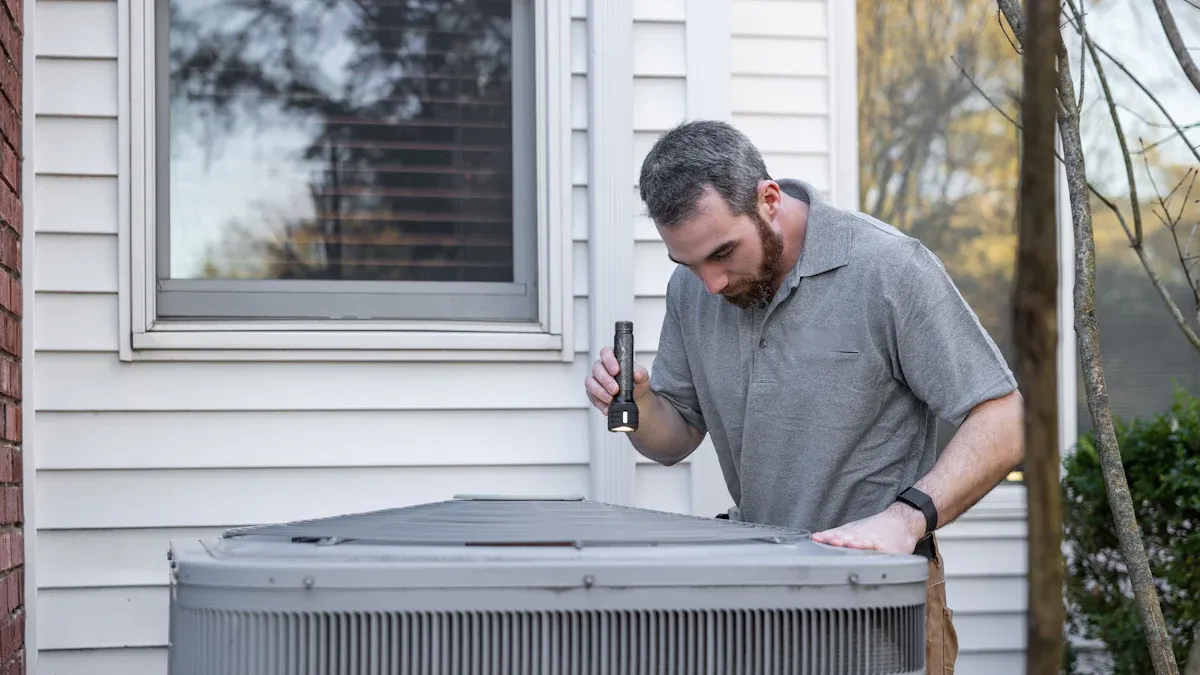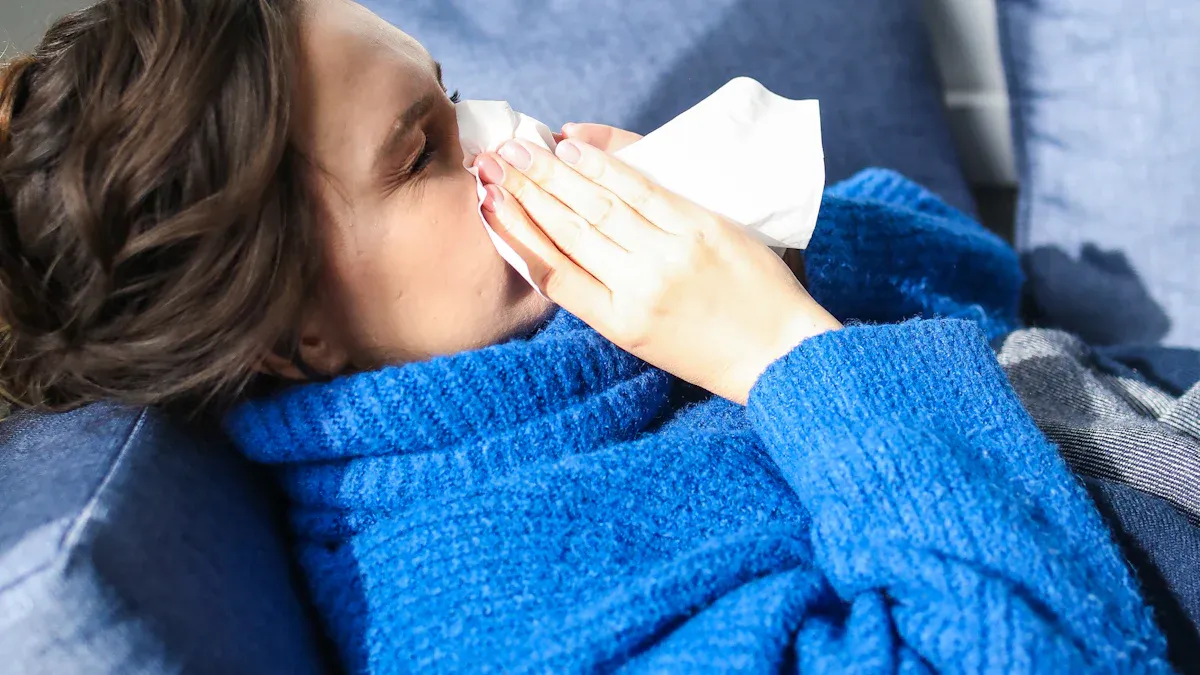
Yes, some things can make an air purifier make allergies worse. You may see more allergens in the air if you use the wrong filter or do not take care of your air purifier. Ozone-producing models can also make allergies worse, especially for people who have allergies all year. If you put your air purifier in the wrong place or do not pay attention to where allergens come from, it may not work well.
Knowing about these problems helps you use your air purifier better and breathe easier every day.
Key Takeaways
- Pick a real HEPA filter for your air purifier. It can catch small things like dust, pollen, and pet dander.
- Change or clean your air purifier filters often. This helps it work well and stops allergens from piling up.
- Do not use air purifiers that make ozone. Ozone can bother your lungs and make allergies worse.
- Put your air purifier in the middle of the room or near you. Keep windows closed so new allergens do not get in.
- Use your air purifier the right way and take care of it. This can help lower allergy problems and give you cleaner air at home.
Filter Type Matters
HEPA vs. Non-HEPA Air Purifiers
The filter inside your air purifier is very important for allergies. HEPA filters are special because they follow strict rules from the U.S. Department of Energy. These filters catch almost all tiny particles, even ones as small as 0.3 microns. They grab dust, pollen, pet dander, and mold spores. These things often cause allergies. Non-HEPA filters do not follow these rules. They only catch bigger particles, so small allergens can stay in the air.
Tests in labs show HEPA filters remove almost all tiny particles. Non-HEPA filters do not work as well, especially with small allergens. For example, HEPA filters can lower cat and dust mite allergens by up to 60%. Non-HEPA filters may only lower them by less than 20%. This is why people pick HEPA filters for better allergy help.
HEPA filters also work better for dog allergens and other particles in the air. Non-HEPA filters do not have the same proof or results. If you want your air purifier to help with allergies, pick a real HEPA filter.
Wrong Filter for Air Purifier Allergies
Using the wrong filter in your air purifier can make allergies worse. Some filters do not catch small allergens. For example, ionic or electrostatic air purifiers can make ozone. Ozone can bother your lungs and make allergy symptoms worse. Cheap fiberglass filters or old filters can let allergens build up and go back into the air.
If you use a filter that does not fit or is not made for allergies, more allergens can stay inside. Even a HEPA filter will not work if it is fake or dirty. Always make sure your air purifier uses a real HEPA filter and change it when needed. This helps your air purifier work best and keeps your allergies under control.
Tip: Change your air purifier filter every three months or sooner if you see dust or smell odors. Clean air purifiers help most with allergies.
Maintenance Issues

Dirty or Clogged Filters
If your air purifier filter is dirty, allergies can get worse. When you do not clean or change the filter, it cannot catch dust or pollen. Pet dander and mold spores also stay in the air. These things can make you sneeze or cough more. Your eyes might get itchy too. Sometimes, a clogged filter lets mold and bacteria grow inside. This can spread around your house and make allergies or asthma worse.
Note: When the filter is dirty, the air purifier works harder. It uses more power and might break down faster.
You might notice these problems if you do not clean your air purifier:
- More dust and allergens floating in the air
- Worse allergy symptoms like sneezing or stuffy nose
- Bad or musty smells coming from the machine
- Higher energy bills because the purifier works too hard
Cleaning and changing filters often helps stop these problems. This keeps you healthy and your air purifier working well.
Filter Changes and Air Purifier Performance
Changing the filter on time is very important for your air purifier. If you forget, the filter fills up and cannot catch new allergens. More allergens stay in your home and can make allergies worse. You might see more dust on your furniture. This means the air purifier is not working right.
Experts say you should do these things:
- Change HEPA filters every 3 to 12 months, depending on use and if you have pets or allergies.
- If you have pets or someone smokes, change filters every 3 months.
- Wash washable filters with cool water and let them dry before using again.
- Clean or replace pre-filters more often because they catch bigger stuff.
- Watch for filter lights on your air purifier. These lights tell you when to change the filter.
If you follow these tips, your air purifier will catch more allergens and help your allergies. You will also save energy and keep your machine from breaking.
Ozone and Ionizers
Ozone-Producing Air Purifiers
Some air purifiers make ozone as they work. These machines change oxygen into ozone gas. They are called ozone generators or ionizers. Many people think ozone makes air cleaner. But ozone can actually cause problems in your home. Ozone does not get rid of dust, pollen, or pet dander. It just adds a new gas to the air inside your house.
Note: Ozone is a strong gas that can hurt your lungs. This is even worse if you have allergies or asthma.
Here is what can happen with ozone-producing air purifiers:
- Ozone can build up inside and make air pollution worse.
- Too much ozone can bother your nose, throat, and lungs.
- Kids, older people, and those with breathing issues are at higher risk.
- Ozone can start asthma attacks and make allergies worse.
- Health experts say not to use these in rooms where people stay.
- Some air purifiers with ionizers also make ozone, even if they do not say so.
To stay safe, pick air purifiers that are certified for low or no ozone.
Effects on Allergy Symptoms
Ozone in your house can make allergy symptoms worse. Breathing in ozone can bother your airways. This can make you cough or feel tightness in your chest. You might also have trouble breathing. If you already have allergies, ozone can make them worse. You may sneeze more, have itchy eyes, or get a runny nose.
Ozone does not remove allergens from the air. It can make your body react more to things that cause allergies. People with asthma or other breathing problems can have even more trouble. Breathing ozone for a long time can even hurt your lungs forever.
Tip: Always check if your air purifier makes ozone before you buy it. Pick models that do not use ionizers or ozone generators. This keeps your air safe and clean for everyone at home.
Placement and Usage
Room Size and Air Purifier Effectiveness
What makes an air purifier work best in your home? The size of your room plays a big role. You need to match the air purifier’s capacity to the exact square footage of your space. If you use a purifier that is too small, it cannot clean enough air. If you pick one that is too large, you may spend more money than needed. This match helps you get the most out of your air purifier and improves indoor air quality.
Here is a table to help you choose the right air purifier for your room:
| Room Size Category | Square Footage Range (sq ft) |
|---|---|
| Small | Under 150 |
| Medium | 150 to 350 |
| Large | 350 to 650 |
| Extra-Large | 650 and above |
You should always check the product label for the recommended room size. This step ensures the air purifier can remove common allergens like dust, pollen, and pet dander from your space. When you select the right size, you improve the effectiveness of the device and help reduce allergies.
Open Windows and Allergen Sources
What happens if you place your air purifiers in the wrong spot? You may not get the clean air you expect. Air purifiers need clear airflow. If you put them too close to walls or furniture, you block the intake and outlet. This mistake lowers the amount of air cleaned and lets indoor allergens build up.
You should avoid placing air purifiers in corners or near the floor. These spots can have stagnant air zones where pollutants collect. In some cases, these zones hold up to 30 times more allergens. For best results, place your air purifier in the center of the room or near where you spend the most time. In bedrooms, keep it close to your bed to improve indoor air quality while you sleep.
Tip: Keep windows and doors closed when using air purifiers. Open windows let in new allergens from outside, making it harder for your device to control indoor allergens.
Proper placement and usage help your air purifier remove allergens and protect you from allergy symptoms.
How to Reduce Allergy Symptoms

Choosing the Right Air Purifier
Picking the right air purifier can help with allergies. Look for machines that have features to trap allergens and clean the air. The table below shows what you should look for when picking an air purifier:
| Feature | Importance/Benefit |
|---|---|
| True HEPA Filter | Captures 99.97% of particles as small as 0.3 microns, including pollen, dust mites, and pet dander. |
| Clean Air Delivery Rate | Matches room size for effective allergen removal and faster cleaning. |
| Sealed Design | Prevents air leakage, making sure all air passes through the filter. |
| Activated Carbon Filter | Removes odors and gases, improving air quality. |
| Washable Pre-Filters | Trap larger particles, extending the life of the main filter. |
| Quiet Operation | Allows you to run the device in bedrooms or workspaces without noise disturbance. |
| Smart Sensors | Adjust fan speed based on allergen levels for better performance. |
| Filter Replacement Frequency | Affects maintenance cost and keeps the purifier working well. |
Always check if your air purifier is a True HEPA model. Stay away from “HEPA-type” or “HEPA-like” models. These do not meet the strict rules for removing allergens.
Best Practices for Air Purifier Allergies
Using your air purifier the right way helps lower allergens. It also makes you feel better at home. Here are some easy tips:
- Put air purifiers in the middle of rooms or near beds to catch more allergens.
- Keep windows and doors shut so new allergens do not get inside.
- Change HEPA and carbon filters every 3–6 months to keep the machine working well.
- Clean washable pre-filters often so dust does not build up.
- Use air purifiers with carbon filters to get rid of bad smells and gases.
- Use other steps too, like vacuuming with HEPA filters, washing pet beds, and keeping humidity under 50%.
- Watch air quality and move your air purifier if you need to clean a different spot.
Tip: If you take care of your air purifier and put it in the right place, you can lower allergy symptoms like sneezing, coughing, and itchy eyes.
When you follow these steps, air purifiers can help you control allergies and make your home healthier. These tips help the machine remove allergens instead of letting them stay in the air.
If you use the wrong filter, your allergies can get worse. Not changing filters or using ozone air purifiers can also cause problems. Many people forget to clean filters or think about where allergens come from.
- Pick HEPA filters to help with allergies.
- Put your air purifier in a good spot and use it a lot.
- Clean or change filters when the instructions say to.
If you do these things, air purifiers can help you breathe better and keep your home healthier.
FAQ
What happens if you use the wrong filter in your air purifier?
You may notice more dust and allergens in your home. The wrong filter cannot trap small allergy triggers. This can make your symptoms worse instead of better.
What signs show your air purifier needs maintenance?
You might see more dust, smell bad odors, or hear strange noises. Allergy symptoms can get worse. The filter light may turn on. These signs mean you should clean or change the filter.
What makes ozone air purifiers risky for allergies?
Ozone air purifiers release a gas that can irritate your lungs. This gas does not remove allergens. It can make breathing harder, especially if you have allergies or asthma.
What is the best way to place your air purifier for allergies?
Put your air purifier in the center of the room or near your bed. Keep windows and doors closed. Make sure nothing blocks the airflow. This helps the purifier clean the air better.
What extra steps help air purifiers reduce allergies?
You can vacuum with a HEPA filter, wash bedding often, and keep pets out of bedrooms. These steps lower allergens in your home and help your air purifier work better.
See also
What Happens Inside an Air Purifier When It Cleans the Air
What to Expect When Using an Air Purifier at Home
Air Purifier Myths, Real Results, and How to Avoid Being Scammed
